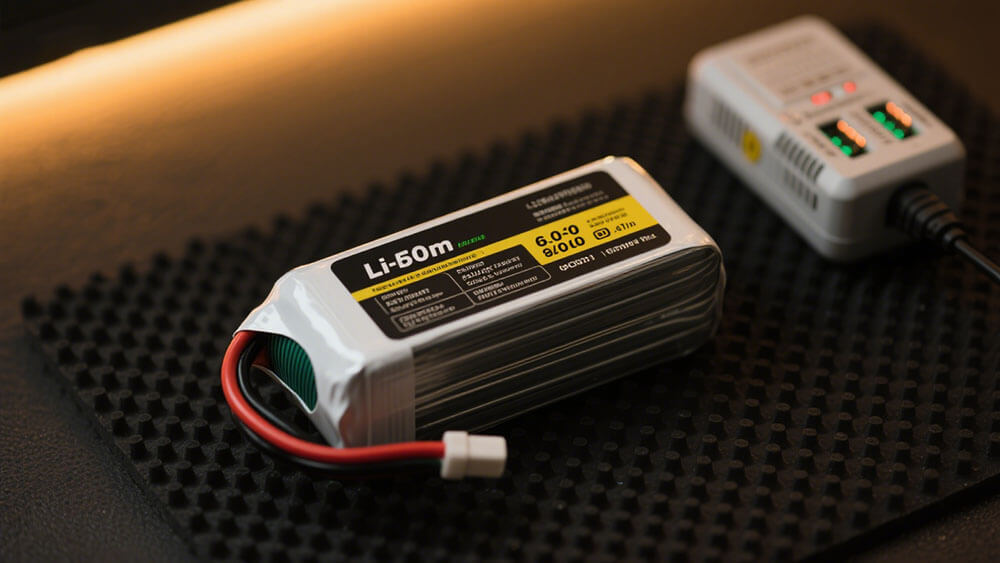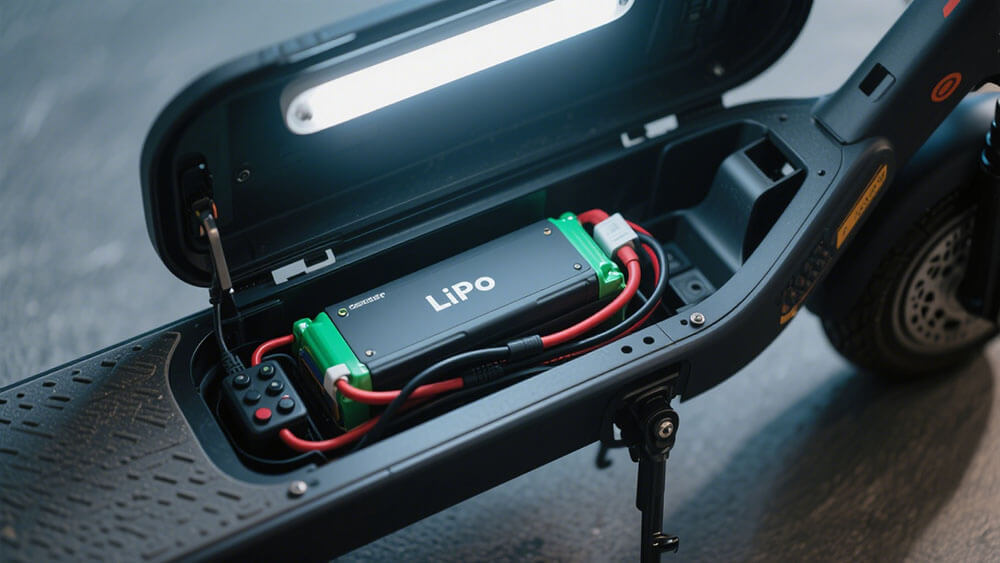
LiPo battery voltage refers to the electrical potential of lithium polymer batteries, a critical factor influencing performance and compatibility. Each LiPo cell has a nominal voltage of 3.7V. Configurations like 1S, 2S, and 3S combine multiple cells in series to scale voltage for diverse applications. For example:
1S: 3.7V nominal
2S: 7.4V nominal
3S: 11.1V nominal
Such variations allow you to match the power needs of devices like drones, RC vehicles, and industrial tools.
Key Takeaways
LiPo batteries usually have 3.7V per cell. Configurations like 1S, 2S, and 3S raise voltage for devices.
Check LiPo battery voltage often to avoid overcharging or draining too much. This helps the battery last longer and stay safe.
Picking the right LiPo setup is important. Match the battery’s voltage and size to your device for best results.
Part 1: Understanding LiPo Battery Voltage

1.1 Voltage Ranges for a Single Cell
LiPo batteries, or lithium-polymer batteries, are known for their high energy density and versatility. Each single cell in a LiPo battery has a nominal voltage of 3.7V. This value represents the average voltage during discharge. However, the actual voltage range varies depending on the state of charge. A fully charged cell reaches 4.2V, while a depleted cell drops to around 3.0V. Operating outside this range can damage the battery or reduce its lifespan.
The voltage range of a single cell is crucial for determining the overall performance of the battery pack. For example, devices requiring stable power output rely on the consistent voltage provided by LiPo cells. This characteristic makes them ideal for applications like drones, robotics, and consumer electronics.
Tip: Always monitor the voltage of your LiPo batteries using a battery management system (BMS) to prevent overcharging or deep discharging. Learn more about BMS here: Battery Management System Operation & Components.
1.2 How Voltage Scales with Configuration
LiPo batteries achieve higher voltage outputs by connecting multiple cells in series. Each additional cell increases the total voltage by 3.7V (nominal). For instance, a 2S LiPo battery, which contains two cells in series, has a nominal voltage of 7.4V. Similarly, a 3S configuration provides 11.1V. This scaling behavior allows you to customize the battery’s voltage to match the requirements of specific devices.
The following table illustrates how voltage scales with different configurations and cell types:
Configuration | Number of Cells | Voltage Output |
|---|---|---|
1S (LiPo) | 1 | 3.7V |
2S (LiPo) | 2 | 7.4V |
3S (LiPo) | 3 | 11.1V |
4S (Li-ion) | 4 | 14.4V |
E-bike Battery | 36V (Li-ion) | 36V |
Starter Battery | 18 (Lead Acid) | 42V |
This scalability makes LiPo batteries suitable for a wide range of applications, from small consumer electronics to industrial tools. For example, 2S LiPo batteries are commonly used in RC vehicles, while higher configurations power drones and UAVs.
1.3 Table of Voltage Ranges for Common Configurations
Understanding the voltage ranges for common LiPo configurations is essential for optimizing performance and ensuring safety. The table below provides a detailed breakdown of nominal voltage, fully charged voltage, and depleted voltage for 1S, 2S, and 3S configurations:
Configuration | Nominal Voltage | Fully Charged | Depleted |
|---|---|---|---|
1S | 3.7V | 4.2V | 3.0V |
2S | 7.4V | 8.4V | 6.0V |
3S | 11.1V | 12.6V | 9.0V |
Additionally, the state of charge for a 3S LiPo battery can be summarized as follows:
State of Charge | Voltage |
|---|---|
Fully Charged | 12.6V |
50% Charged | 11.1V |
Depleted | 9.0V |
These values highlight the importance of monitoring voltage levels during operation. Overcharging or discharging beyond the specified range can lead to reduced performance, overheating, or even safety hazards.
Note: If you are unsure about the right configuration for your application, consider consulting a professional. Large Power offers custom battery solutions tailored to your needs.
Part 2: Voltage and Configuration Comparison

2.1 1S Configuration: Characteristics and Use Cases
A 1S LiPo battery consists of a single lithium-polymer cell with a nominal voltage of 3.7V. This configuration is lightweight and compact, making it ideal for applications where size and weight are critical. Devices like wearables, small drones, and portable consumer electronics often rely on 1S batteries due to their simplicity and efficiency.
Key Characteristics of 1S LiPo Batteries:
Lightweight: The flexible casing of LiPo batteries reduces weight compared to traditional rechargeable batteries.
High Energy Density: These batteries store significant energy relative to their size, ensuring longer runtimes for compact devices.
Higher Discharge Rates: 1S configurations can deliver high discharge rates, supporting devices that require bursts of power.
Tip: Regularly monitor the voltage of your 1S LiPo battery to prevent over-discharging, which can lead to reduced performance and safety risks.
2.2 2S LiPo Batteries: Characteristics and Use Cases
A 2S LiPo battery contains two cells connected in series, resulting in a nominal voltage of 7.4V. This configuration balances power output and size, making it suitable for mid-range applications. RC vehicles, drones, and certain industrial tools often use 2S LiPo batteries for their reliable performance.
Performance Comparison: 2S LiPo vs. Lithium-ion Batteries
The table below highlights the differences between 2S LiPo batteries and lithium-ion batteries:
Characteristic | 2S LiPo | Lithium-ion |
|---|---|---|
Nominal Voltage | 7.4V | 3.6-3.7V (single cell) |
Energy Density | 130-200 Wh/kg | 150-250 Wh/kg |
Max Discharge Rate | Typically 30C or higher | Usually 1C-3C, up to 10C for high-performance |
Charge Rate | Typically 1C-2C | Usually 0.5C-1C |
Cycle Life | 300-500 cycles | 500-1000 cycles |
Self-discharge Rate | Higher | Lower, about 1-2%/month |
Flexibility | High, can be shaped | Low, typically rigid casing |
Safety | More sensitive, needs careful handling | Relatively stable, but still requires caution |
Main Applications | RC models, drones, wearables | Smartphones, laptops, electric vehicles |
The 2S configuration offers higher discharge rates and flexibility, making it a preferred choice for high-performance devices. However, it requires careful handling to avoid overcharging or physical damage.
2.3 3S and Higher Configurations: Characteristics and Use Cases
A 3S LiPo battery includes three cells in series, delivering a nominal voltage of 11.1V. Higher configurations, such as 4S or 6S, further increase voltage, catering to devices with demanding power requirements. These configurations are commonly used in drones, RC aircraft, and industrial-grade equipment.
Advantages of 3S and Higher LiPo Batteries:
High Power Output: Suitable for applications requiring significant energy, such as drones and RC vehicles.
Lightweight: Despite their power, these batteries remain lightweight, ensuring agility for devices like drones.
Compact Form Factor: The design allows them to fit into tight spaces, enhancing versatility.
Fast Charging: Reduces downtime, enabling quicker operational readiness.
Limitations of 3S and Higher LiPo Batteries:
Safety Concerns: These batteries are sensitive to overcharging and physical damage, requiring proper storage and handling.
Shorter Lifespan: Compared to LiFePO4 batteries, 3S configurations have a shorter cycle life.
Cost: High-capacity models can be expensive, impacting budget considerations.
Maintenance Needs: Regular monitoring and maintenance are essential to preserve battery health.
Note: For industrial applications, consider consulting a professional to determine the optimal configuration for your needs. Large Power offers custom battery solutions tailored to specific requirements.
The choice between 1S, 2S, 3S, and higher configurations depends on your device’s power demands and operational environment. Understanding these differences ensures you select the right battery for optimal performance and safety.
Part 3: Applications of LiPo Configurations

3.1 Drones and UAVs
LiPo batteries play a pivotal role in powering drones and UAVs (Unmanned Aerial Vehicles). Their high energy density ensures extended flight times without adding unnecessary weight. You’ll find that 3S or 4S configurations are commonly used in consumer drones, while professional-grade UAVs often require 6S or higher configurations for enhanced performance.
The lightweight nature of LiPo batteries allows drones to maintain agility and stability during flight. Additionally, their ability to deliver high discharge rates supports the power demands of motors during rapid maneuvers or takeoffs. However, safety considerations are critical in this application. Overcharging or physical damage can lead to overheating, which may compromise the drone’s operation.
Tip: Always use a battery management system (BMS) to monitor voltage levels and ensure safe operation. Learn more about BMS here: Battery Management System Operation & Components.
3.2 RC Vehicles and Boats
RC vehicles and boats rely heavily on LiPo batteries for their high power output and lightweight design. A 2S or 3S configuration is ideal for most RC cars, while larger models or boats may require 4S or higher configurations to achieve optimal performance.
The high energy density of LiPo batteries allows RC enthusiasts to enjoy longer run times without frequent recharging. Additionally, their ability to deliver bursts of power ensures quick acceleration and high speeds. However, you must consider safety precautions, such as avoiding deep discharges, to maintain battery health.
Note: For custom battery solutions tailored to your RC needs, consult Large Power’s experts here: Custom Battery Solutions.
3.3 Industrial and Commercial Electronics
In industrial and commercial electronics, LiPo batteries are valued for their versatility and efficiency. Applications range from robotics to medical devices and even security systems. Their lightweight design and high energy density make them suitable for portable tools and equipment.
For industrial-grade applications, higher configurations like 6S or 8S are often used to meet demanding power requirements. These batteries provide consistent performance, even in harsh environments. However, safety considerations, such as proper storage and handling, are essential to prevent operational risks.
Sustainability Note: LiPo batteries contribute to sustainable energy solutions in industrial applications. Learn more about sustainability efforts here: Sustainability at Large Power.
For businesses seeking reliable and application-specific solutions, Large Power offers custom battery configurations designed to meet your unique requirements. Explore our offerings here: Custom Battery Solutions.
Understanding LiPo battery voltage and configurations is essential for optimizing device performance and ensuring operational safety. Selecting the right configuration enhances efficiency while reducing risks like overheating or overcharging. Businesses should prioritize application-specific needs and adhere to safety protocols to maintain reliability and compliance.
Safety Aspect | Description |
|---|---|
Electrical Safety | Ensures safe operation under normal and fault conditions, including overcharge and over-discharge. |
Mechanical Safety | Assesses physical integrity against damage from puncture, crush, and impact. |
Thermal Safety | Evaluates performance under high and low-temperature conditions. |
Environmental Safety | Examines behavior under exposure to humidity and vibration. |
Electromagnetic Compatibility | Ensures no harmful electromagnetic interference is emitted and resistance to external fields. |
Benefits of Certification | Safety Assurance: Reduces risk of fires and explosions. |
Regulatory Compliance: Meets standards for market acceptance. | |
Quality and Reliability: Instills confidence in users. | |
Global Market Access: Facilitates international trade. | |
Liability Reduction: Lowers risk for manufacturers and retailers. |
By understanding these aspects, you can make informed decisions that align with your operational goals and ensure long-term success.
FAQ
1. What is the difference between nominal voltage and fully charged voltage in LiPo batteries?
Nominal voltage refers to the average operating voltage of a lithium-polymer cell (3.7V). Fully charged voltage is the maximum voltage (4.2V) when the battery is fully charged.
2. Why are high discharge rates important for LiPo batteries?
High discharge rates allow LiPo batteries to deliver bursts of power, making them ideal for devices like drones and RC vehicles that require rapid energy output.
3. How do you choose the right configuration for your device?
Consider your device’s power requirements, size constraints, and safety considerations. Match the configuration’s voltage and capacity to ensure optimal performance and longevity.




